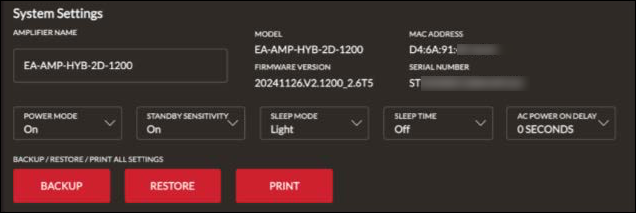Configure tab
The default tab that displays system information such as the Model number, MAC Address, Firmware Version, Serial Number, and general settings. Click Apply at the bottom of the page to save changes.
System Settings
-
Amplifier Name: Enter a meaningful name for the amplifier. This is typically the name of the playback location like "patio" or "outdoor space."
-
Power Mode: By default, the amplifier is always on. Use the drop-down to make one the following selections.
-
Always On: The amplifier does not turn off unless you use the power switch.
-
Audio Sense: The amplifier turns on when it detects an audio signal from the connected source. Learn more.
-
12V Trigger: The amplifier turns on when it receives a 12V input. Learn more.
-
-
Standby Sensitivity: Set the mV input for the amplifier to "sense" to turn on when Audio Sense is selected as the Power Mode. Set it lower for quieter source signals and higher for louder source signals.
-
Sleep Mode: Select whether the amplifier drops the network connectivity when it's turned off.
-
Light: Network connectivity continues when the amplifier turns off (recommended).
-
Deep: Network connectivity is dropped when the amplifier turns off. This is not recommended if the amplifier is in use with a control system or OvrC.
-
-
Sleep Time: If the Power Mode is set to Audio Sense, this is the time it takes for the amplifier to go into standby after it does not detect a source signal.
-
AC Power On Delay: The number of seconds it takes for the amplifier to fully power on after it receives the initial "on" signal (12V or Audio Sense). Use this field to avoid sudden draw surges when a large amount of equipment is powered on simultaneously or to power the amp on in a particular order compared to the rest of the equipment.
-
Backup: Backs up the current amplifier configuration.
-
Restore: Use to restore a configuration file.
-
Print: Prints the current amplifier settings.
IP Settings
Disable Use DHCP to manually set the IP Address, Subnet Mask, and DNS Server, and Gateway Address.
Pro Tip: Use DHCP or a MAC reservation in the router to avoid IP conflicts or loss of connection if the IP scheme changes.


